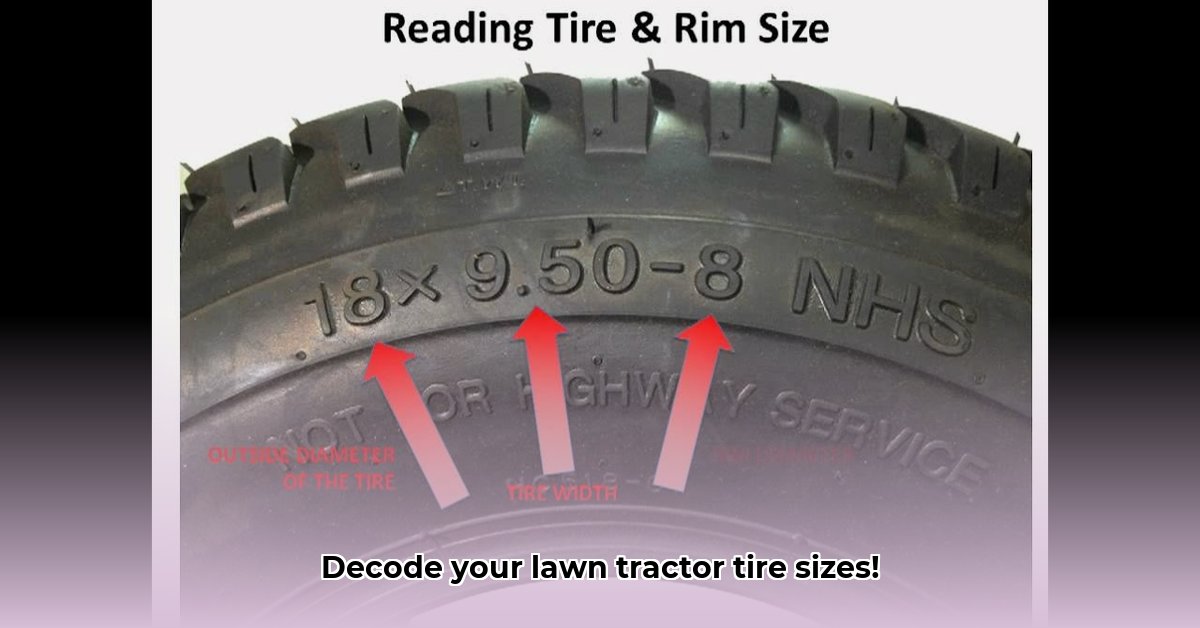
Lawn tractor tires are critical for performance, longevity, and safety. Understanding how to measure and select the right tires is essential for any lawn care enthusiast. This guide provides a step-by-step process to help you choose the perfect tires for your needs. For more information on lawn tractor rims, check out this helpful resource: Lawn Tractor Rims.
Decoding the Tire Code: Understanding the Numbers
The tire size is usually printed on the sidewall, appearing as a code like "18x8.50-8". Let's break down this code:
Find the Code: Locate the numbers and letters on the tire sidewall.
Understanding the Numbers: The code comprises three key pieces of information:
Wheel Diameter (First Number): This number (e.g., 18) indicates the wheel's diameter in inches. This is the diameter of the wheel itself, not the entire tire.
Tire Width (Number with Decimal): The next number (e.g., 8.50) represents the tire's width in inches, measured from one sidewall to the other at its widest point.
Rim Diameter (Final Number): The final number (e.g., 8) specifies the diameter of the wheel rim (in inches) that the tire fits onto. Ensure this matches your wheel’s rim diameter.
Putting it All Together: Using the example "18x8.50-8", this means an 8-inch rim diameter on an 18-inch wheel, with an 8.50-inch wide tire.
Additional Markings: Look for load rating (weight capacity) and potentially a speed rating (though less critical for lawn tractors).
Always Check the Manual: Before purchasing new tires, consult your lawn tractor's owner's manual for compatibility and safety recommendations. Using incorrect tires can affect performance and stability. Why risk it?
Picking the Right Tire: Terrain Considerations
Choosing the right tire depends on your mowing terrain, much like choosing the right shoes for an activity.
Pneumatic vs. Solid Tires: Pneumatic tires (air-filled) provide a smoother ride and better grip but are susceptible to punctures. Solid tires are puncture-proof but offer less comfort and traction on uneven surfaces. Choosing between them involves trading off comfort and puncture resistance. Which is more important to you?
Bias-Ply vs. Radial-Ply Tires: Bias-ply tires are cheaper but wear out faster. Radial-ply tires are more expensive but are more durable, providing superior lifespan and a smoother operation. The longer lifespan usually offsets the higher initial cost over time.
Turf Tires vs. All-Terrain Tires: Turf tires protect your lawn and provide good traction on grass. All-terrain tires are better for rough terrain, offering superior grip on uneven ground. The choice depends on your lawn's condition and the terrain you're mowing.
Measuring Your Existing Tires: An Alternative Approach
If the tire size isn't clearly stamped, measuring your existing tires can be a useful backup. However, this method is less accurate than reading the code directly.
Tire Width: Measure the tire's widest point in inches using a tape measure.
Wheel Diameter (Rim Diameter): Measure the wheel's diameter where it connects to the tractor.
Overall Tire Diameter: Measure the tire's diameter from the ground, across the top, and back to the ground.
Important Note: Even with measurements, always confirm compatibility with your owner’s manual.
Troubleshooting Tire Troubles: Identifying and Addressing Issues
Poor traction, vibrations, or uneven tire wear often indicate problems. Investigate tire pressure and inspect for damage. These issues often point to using incorrect tires or a deeper mechanical problem. A professional mechanic should be consulted if you're unsure about diagnosing and fixing the problem -- safety first!
How to Choose the Best Lawn Mower Tires for Different Terrains
Key Takeaways:
- Proper tire selection significantly impacts performance, safety, and the lifespan of your lawn tractor.
- Understanding tire size codes is essential for correct replacement tire selection.
- Tread patterns influence traction on varied surfaces.
- Proper tire pressure is critical for traction and longevity.
- Budget and mowing needs influence tire quality choice.
Choosing Your Tires: A Step-by-Step Guide
Assess your terrain: Are you mowing on flat, manicured lawns or hilly, rugged terrain?
Consult your owner's manual: This document specifies the correct tire sizes.
Select tires with the right tread pattern: Choose lug tires for rugged terrain and turf tires for gentler slopes.
Maintain correct tire pressure: Regularly check and adjust pressure to the manufacturer's recommendations.
Consider your budget and mowing frequency: More durable tires are more expensive but will last longer.
Choosing the right tires is crucial for safe and efficient lawn mowing. Understanding these factors ensures you select the perfect tires for your specific needs.